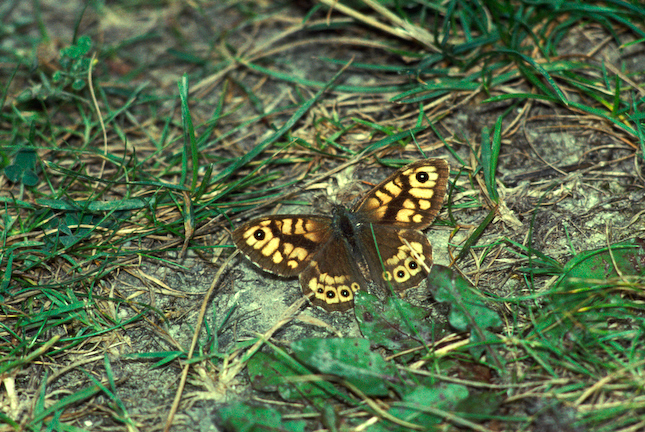Butterflies
Skippers
Whites
Hairstreaks
Blues and Coppers
Admirals
Vannesids
Fritillaries
Browns
Emergence 1st -2nd
| Year | First | Second |
| 1976 | 15 may* | |
| 1977 | 27 may* | |
| 1978 | 27 may* | |
| 1979 | 5 june | |
| 1980 | 19 may | |
| 1981 | 31 may | |
| 1982 | 14 may | 20 july |
| 1983 | 4 june | 27 july |
| 1984 | 4 june | 7 aug |
| 1985 | 12 aug | |
| 1986 | ||
| 1987 | 19 aug | |
| 1988 | 25 july | |
| 1989 | ||
| 1990 | ||
| 1991 | ||
| 1992 | ||
| 1993 | ||
| 1994 | ||
| 1995 | ||
| 1996 | ||
| 1997 | ||
| 1998 | ||
| 1999 | ||
| 2000 | ||
| 2001 | ||
| 2002 | ||
| 2003 | ||
| 2004 | ||
| 2005 | ||
| 2006 | ||
| 2007 | ||
| 2008 | ||
| 2009 | ||
| 2010 | ||
| 2011 | ||
| 2012 | ||
| 2013 | ||
| 2014 | ||
| 2015 | ||
| 2016 | ||
| 2017 | ||
| 2018 | ||
| 2019 | ||
| 2020 |
Submit Your Records & Comments Here
Butterfly Survey 1976-2015
Wall Brown
_-_Wall_Brown_-_Lasiommata_megera_-_Mauerfuchs_(21493780080).jpg)

typical top - abberant below
wingspan: 40mm
When I started looking at butterflies in the late 1960's this was a very common butterfly. It would be found on open patches and rough areas adjacent to farmland, also present on downland around White Hill where this dark version was photographed. the butterfly was also present in large parks and gardens. The butterfly gets its common name 'wall' from the habit of sunning upon walls, where it was most noticable, but it also settled on bare patches of sun baked earth.
Now very scarce, none recorded since the late nineteen eighties in the area of the study. In 1993 Eric Philp wrote that the butterfly was more prevalent in coastal areas than inland and that it was not common. This trend seems to have continued and records I've seen from 2021 have all been from areas adjacent to the Thames and Medway
double brooded - might be seen on the wing from spring onwards and again in mid Summer until late September/October
Larval Foodplant: grasses (cock's foot)
Status: very scarce - a victim of climate change, affecting poerhaps the growth and scarcity of the food plant.
© Rodney Compton
WH - White Hill Shoreham, BC - Bromley Common, Ha Hayes --BN Bromley North - Ey Eynsford - Orp Orpington HE High Elms Lull Lullingstone
